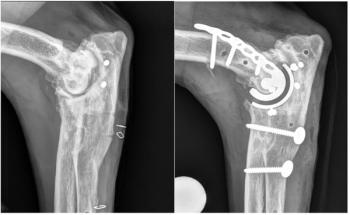
Regional nerve blocks (Proceedings)
Regional nerve blocks as part of a total multi modal approach to pain management for the dental patient.
Regional nerve blocks as part of a total multi modal approach to pain management for the dental patient. Regional blocks interrupt impulse transmission along the pain pathway to inhibit the pain response. Placing a regional nerve block can benefit the patient, not only perioperatively, but postoperatively as well. One of the greatest benefits of the regional block is that the anesthetist is able to maintain the patient at a much lighter plane of anesthesia, thereby, significantly reducing the risk of anesthesia. This is extremely important as anesthesia is frightening to the pet owner and can be a major contributing factor in non-compliance with regards to the pet's professional dental care. Regional blocks also allow for a much smoother recovery. The animal recovers without the initial pain response that can occur in other surgical procedures. For instance, a dog recovering from a spay procedure will have some pain on recovery once the inhalant is cleared and the cerebral cortex recognizes the pain impulse. When a regional block is placed, the pain impulse never reaches the cerebral cortex, so even when the animal is fully awake, there is no recognition of pain.
The drugs of choice
Lidocaine 2% and bupivicaine 0.5% are used in combination in a 1:4 ratio.
Bupivicaine can be used alone as well. Lidocaine was added to increase the time of onset of the agent as it was thought that bupivicaine could take up to 15 minutes before taking effect. However, it is now thought that the time of onset is closer to 3-5 minutes of that agent. The duration of bupivicaine is approximately 6-8 hours post administration.
An opioid can be added for prolonged or extremely painful procedures. Human studies have shown that adding an opioid to the mix can extend the efficacy of the block up to 24 hours in duration.
The maximum dose for each agent used is 1 mg/kg.
The amount used depends on the size of the patient and the number of sites to be blocked with the maximum amount of sites being 4 to block all 4 quadrants of the mouth._
Recommended volume for each site is based on the size of the patient.
- Small up to 12 lbs. 0.1-0.3 ml
- Medium 12-50 lbs. 0.3-0.6 ml
- Large 50-80 lbs. 0.8-1.2 ml
- Patients over 80 lbs. 1.4-1.6 ml_
Materials needed
- A 1, 3 or 6 cc syringe with a 22ga x 1 in needle for patients over 30 lbs.
- A 1 cc syringe with a 25 or 27 ga x 5/8” needle for patients under 30 lbs.
The technique
The needle is inserted at the appropriate site. The syringe is aspirated to check for “flash” to avoid injecting into a vessel. If flash is present, then the needle is reinserted and aspiration is repeated. If no flash is present, the drug is injected slowly. Digital pressure is applied for 30-60 seconds after injection to “hold” the agent in place in order to bathe the nerve and achieve a more effective block.
In the maxilla
Caudal Maxillary block-infiltrates the infraorbital nerve at the caudal portion of the canal and provides local anesthesia of the entire ipsilateral side. The foramen is located dorsal to the last molar. The landmark of insertion is located behind the last maxillary molar into the soft tissue. The needle is inserted perpendicular to the maxilla just caudal to the last molar and is advanced no more than halfway. The provides analgesia for the entire ipsilateral side including tooth, bone and soft tissue. It also anesthetizes the pterygopalantine nerve which innervates the palate.
Infraorbital block-infiltrates the infraorbital nerve at the rostral portion of the canal and provides local anesthesia from the 1st premolar to the rostral portion of the maxilla in the mesocephalic patient. This technique provides local anesthesia to the entire ipsilateral side in the cat and brachycephalic patient. The infraorbital canal in these patients is only a few millimeters in length, making this technique the one of choice in these patients. The maxillary technique previously discussed is not necessary to use in the cat and brachycephalic patient. In the mesocephalic patient the foramen lies dorsal to the mesial root of the 3rd maxillary premolar. The lip is retracted dorsally and the foramen is palpated. In the cat, the foramen is much more dorsal to the 1st premolar and is much larger relative to the skull. The syringe is positioned parallel to the maxilla and the needle is inserted through the mucosa in a rostral to caudal direction into the foramen.
In the mandible
Inferior Alveolar Block-infiltrates the inferior alveolar nerve within the mandibular canal on the lingual aspect of the mandible, provides local anesthesia of the entire ipsilateral side. The foramen lies on the lingual side of the mandible above the mandibular notch. It can also be located by drawing a line from the lateral canthus of the eye to the ventral edge of the mandible or by palpating the mandibular notch by running a finger along the ventral portion of the mandible until the notch is reached. The needle is inserted through the skin at the mandibular notch perpendicular and lingual to the mandible. The needle should be inserted about halfway to the hub.
Middle Mental Block-infiltrates the inferior alveolar nerve in the mandibular through the middle mental foramen and provides local anesthesia from the 3rd premolar to the rostral portion of the mandible. The foramen lies on the lateral aspect of the mandible at the apex of the canine and ventral to the mesial root of the 3rd premolar. The landmark for this foramen is the mandibular frenulum. The syringe is positioned parallel to the mandible and the needle is inserted through the mucosa at the base of the frenulum in a rostral to caudal direction. The needle should fit “snugly” into the foramen as opposed to loosely if inserted into soft tissue only.
By adding this protocol to the pain management treatment plan, it allows for a smoother recovery for the patient. More importantly, it provides intraoperative pain control and prevents the nociceptive process. The anesthetist can then keep the patient at a much “lighter” plane of anesthesia. Cardiac output, blood pressure and temperature are stabilized at a lower concentration of inhalant which provides a much safer anesthetic event for the patient.
References
1 Beckman, B.W. “Regional Nerve Blocks Key to Delivering Quality Dental Care” September 2007, 1-3
2 Beckman, B.W. “Regional Nerve Blocks Key to Delivering Quality Dental Care” September 2007, 1-3
3 Beckman, B.W. “Regional Nerve Blocks Key to Delivering Quality Dental Care” September 2007, 1-3
Newsletter
From exam room tips to practice management insights, get trusted veterinary news delivered straight to your inbox—subscribe to dvm360.






